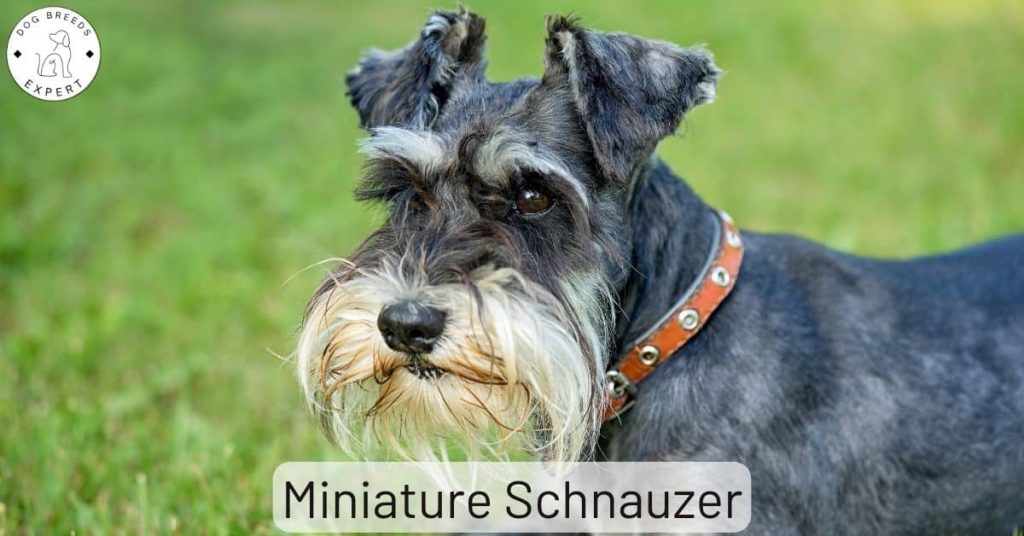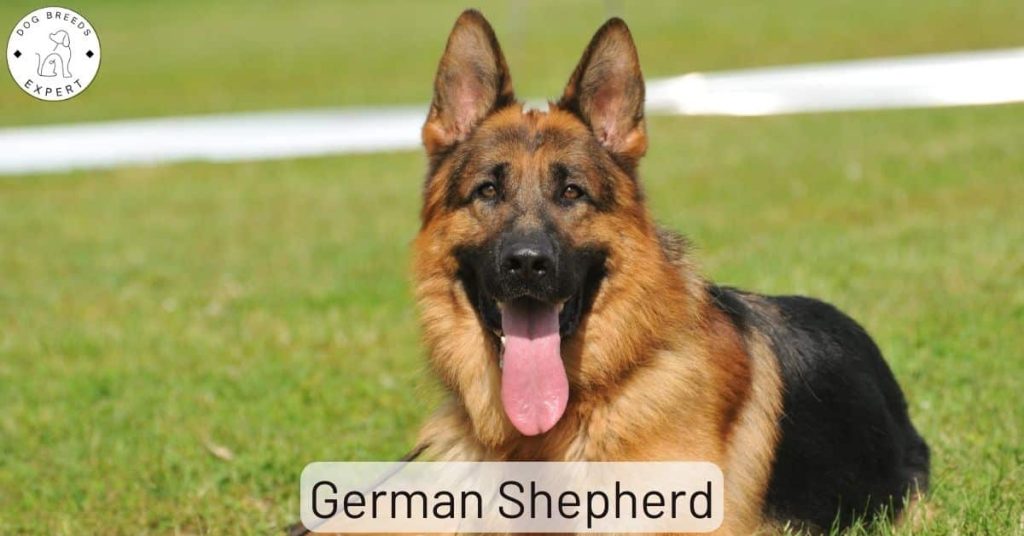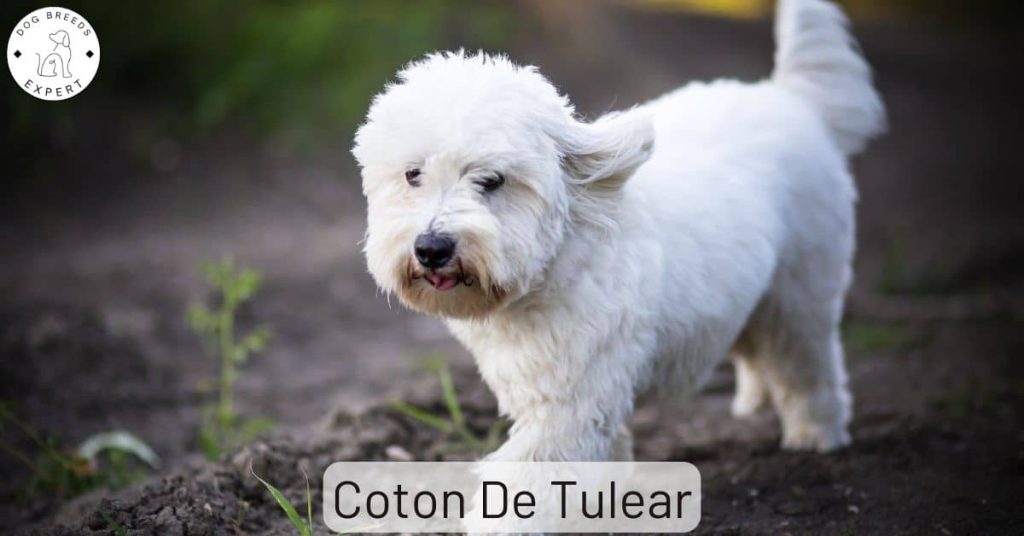Smart, Spunky, Playful
Have you ever wondered how the Miniature Schnauzer got to be so much smaller than his standard and giant cousins? This is a prime example of how breeders can breed-down or miniaturize a larger breed.
In fact, the mini version is less than 1/5 the size of the Giant and 1/3 the size of the Standard Schnauzer.
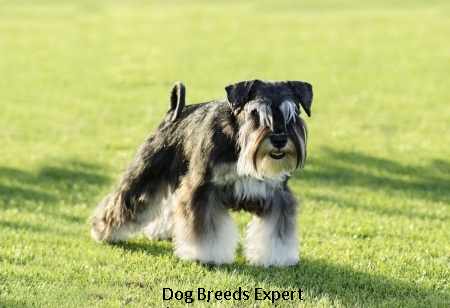
Just a testimony to the incredible breeding abilities of the nineteenth century. Farmers still wanted the strength and intelligence of the larger breeds, but one that could also catch vermin.
They succeeded, and after many generations created the only “Terrier” breed in the American Kennel Club’s Terrier Group that wasn’t of British Origin.
Miniature Schnauzer – Temperament
The miniature size is most common of the Schnauzers, for many reasons. Owners enjoy their affectionate and loyal personalities, which is paired with their playful energy. Their intelligence makes them responsive and quick learners.
These dogs are known to be reasonably good with kids. The Miniature Schnauzer’s size makes it less likely to injure small children and much less intimidating. Children also enjoy the playfulness and energy of the dog.
While they are less liable to hurt little kids, the dogs themselves are at risk. Children should always be taught how to handle small dogs and how to treat them respectfully.

The Miniature Schnauzer is capable of coexisting with other pets, including other canines. It is recommended that they are raised with other pets, as they are typically suspicious of other dogs.
When raised together, a Miniature Schnauzer will often become good friends with their fellow pets, or, at least, tolerant.
Along with being suspicious of unknown animals, a Miniature Schnauzer will be anxious around strangers. They are protective of their owners and specially defensive of their property.
Visit a home with a couple of schnauzers and you’re likely to be besieged by a torrent of barks. Guests must be introduced formally, although, they will probably remain outsiders, regardless. These dogs are not suitable for areas of high population density, as it only makes more people for them to be worried about.
The Miniature Schnauzer is known to run off after something it is curious about. Their natural instinct to hunt smaller creatures, making them chase after any encroaching squirrels.
Once in pursuit, these tiny dogs are reluctant to return. Owners combat this fact by having an enclosure for their Schnauzers when outside. Since the dog is so small, invisible fences are adequate deterrents as well.
While the Miniature Schnauzer’s size may be ideal for sharing an apartment with, their personality is not. The breed’s suspicious nature will have it nervous around neighbors, leading to unwanted behavior.
They are also very vocal, barking at anything and everything that is unusual to them. Anyone nearby will most likely not be too fond of the usual yapping, so they are not recommended for anyone with neighbors especially sensitive to volumes, apartment or not.
The Miniature Schnauzer displays an outward appearance of toughness and courage. This is contrary to their sensitive personalities, which makes them take most things directed at them very seriously.
They are especially sensitive to harsh treatment, and will become stubborn and unresponsive as a result. Despite their sensitivity mentally, these dogs are physically sturdy. They tend to cope well with very cold or sweltering temperatures, but should not be left in them for prolonged periods of time, of course.
A very recognizable trait of the Miniature Schnauzer is its energy. These dogs are fairly energetic, and like to be moving around. They need a proper amount of exercise, despite their size. Providing the dog with ample exercise is helpful, however, as it can help sate its excessive energy.
These dogs are tiny, guard dogs on the exterior. How they treat people significantly differs, depending on the person. They are known to be extremely affectionate towards their owners, which helps display their loyalty.
The Miniature Schnauzer enjoys being a lap dog, a job its size helps it excel at. These dogs are social and do not like being left alone. They are prone to separation anxiety when left alone for too long, and are not recommended for owners who are not home all day.
Owners will often take their Schnauzers to doggy daycare or hire dog sitters to compensate for this.
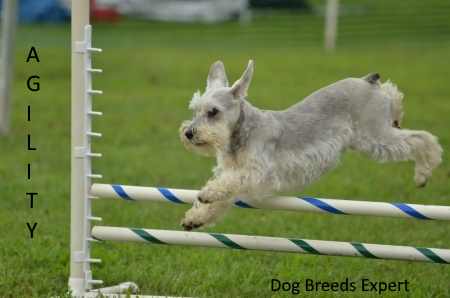
History
The history of the Mini Schnauzer begins with its namesake, the Schnauzer.
Schnauzer comes from the German word or nose or snout. Schnauzers originated in Germany, where they had built up a widespread reputation.
People valued the dog for its working skills as well as its personality. The Schnauzer proved an effective defense, used by their owners to guard their property and themselves.
Generally maintaining their position as a working dog for a long time, the Schnauzer became a common breed in Europe.
These dogs became the interest of breeders in the 1800s attempting to standardize many older breeds. The result of this selective and mixed breeding was many new breeds, of which included the Miniature Schnauzer.
The breeds used to create the Miniature Schnauzer are not known for sure, although, the goal for the new breed was obviously a success.
Breeders hoped to capitalize on the Schnauzer’s already strong ability to get rid of small critters, which they accomplished by making the dog smaller. Its size made it much more suitable for catching such tiny prey.
Soon enough, this tiny, new breed would be one of many to feel the effects of WW1. While countries were focused on the war effort, dog breeding was set on the back burner, and little was accomplished during these years.
Many breeds saw a drop in population, as few could afford to keep pets, due to Europe’s ravaged economy.
While many breeds continued to struggle in the years following the war, the Mini Schnauzer fared comparatively well.
The breed had a strong foundation in Europe and had made its way to the US around 1924. The popularity of these dogs continued to grow, although breeding would not not be a priority until after the second World War.
The wartime industries that the US had built up during WWII led to an enormous boost to their economy. People could afford more luxurious lifestyles, and what’s luxury without a couple dogs? Many dog breeds felt the conspicuous consumerism movement as they jumped in numbers all across the country.
Today, the breed continues to be among the most popular in the world.
Since their registration by the AKC in 1926, the Miniature Schnauzer now holds the ranking as 16th most popular breed in the US.
They remain a very popular dog in Europe as well, particularly in their home country of Germany.
Ease of Training

Training a Mini Schnauzer can be tough if not started properly. This breed is intelligent and will take advantage of its owner’s flaws or weaknesses.
They need the type of owner that can consistently reprimand bad habits without scolding the dog. These dogs are infamously stubborn, and if a bad habit is not ironed out early, it will most likely stay for good.
Housebreaking these dogs can be difficult as their size entails more frequent bathroom breaks. They need consistent reinforcement during this early training stage, which will be relatively time-consuming as well.
Once they are potty trained, however, they fairly well behave. They pick up new tricks and commands with ease and are often enthusiastic learners as well.
Socialization is important when training any breed, but it is especially essential for this one. The Miniature Schnauzer is known for its reputation for being suspicious of unknown people and animals, both of which it will be very vocal about.
By exposing the dog to many different sights, sounds, and smells, it will be less anxious when it encounters something unusual, and hopefully quieter as well. Owners will often take their dogs on frequent walks and to obedience classes to accomplish this.
Vital Statistics
Average Height: 13-14 in. (33-35.6 cm)
Average Weight: 10-18 lbs. (4.5-8.2 kg)
Average Lifespan: 12-14 Years
Colors
The AKC registers 3 coat colors for this breed:
- Black
- Salt and Pepper
- Black and Silver
There are no markings registered by the AKC for this breed.
Origins: Germany
Recognition: FCI: Group 2, AKC: Terrier, ANKC: Utility, CKC: Terrier, KC: Utility, NZKC: Utility, UKC: Terrier
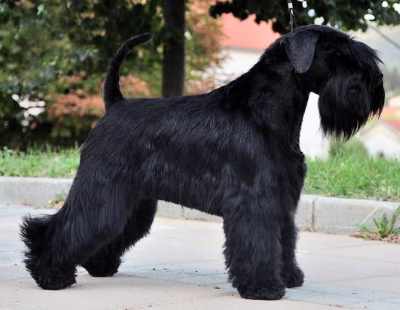
Grooming
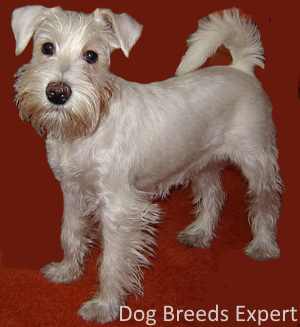
The Miniature Schnauzer is not a difficult dog to groom other than its coat. These dogs have two layered coat that can be difficult to manage if you are going for an impressive looking Schnauzer.
Otherwise, it’s recommended that they are brushed at least 2-3 times a week and professionally groomed. The breed does not shed too much, although it can manage to pick up a bit of a bad smell. It is recommended that they are bathed at least once a month, or as needed.
Taking care of a Schnauzer’s paws is just as important as taking care of their coat. Dogs need their nails regularly clipped, because if they become too long, they may become painful.
They typically will need their nails cut every 2 or 3 weeks, but this is up to the owner. A good way to tell when a dog’s nails are too long is by listening to them clicking against the ground as it moves.
Dogs may not need regular trips to the dentist, but they do need to brush their teeth. The Miniature Schnauzer is a bit lacking when it comes to thumbs, so the owner has to do it for them.
Providing ample dental care is crucial to maintaining the dog’s health. It is recommended that these dogs have their teeth brushed 2-3 times a week, to remove plaque, prevent tartar buildup, and keep their breath fresh.
Dogs need their ears cleaned and checked regularly to prevent ear infections. The Schnauzer’s ears, along with most dogs, are great for trapping bacteria in the wax inside of them.
Cleaning them regularly, at least once a week will help keep the dog healthy and happy.
Protection
As you can probably imagine, the Mini Schnauzer is not a breed you want guarding you, your family, or your property. While larger Schnauzers can make formidable guards, these little dogs’ name suggests otherwise.
Considering their name contains the word, “Miniature” suggests that they may try but won’t inflict much damage on any would-be intruder.
These dogs are small, and despite their courageous and dynamic behavior, would not fare well against an intruder. Their size makes them incapable of being too intimidating.
While they may not be too capable of guarding a house, they make good watchdogs. These dogs are alert, reacting to some of the slightest abnormalities.
Once they notice something unusual, they’ll let the rest of the neighborhood know. This makes the Miniature Schnauzer good for alerting its owner to a threat. While they may not be built for protection, the Mini Schnauzer has the personality for it.
These dogs are alert, wary of anything “off” in their environment. They are also known to be protective of their owners and their property, making them even more suspicious of strangers.
It is important to distinguish friend from foe, although, they will probably bark at both, regardless.
Health Considerations
Dogs get sick, just like people. Owners need to be prepared for unexpected health issues when purchasing a dog. Some breeds are more prone to certain health problems than others, and this must be taken into account to provide the proper health care for the pet.
While Mini Schnauzers are fairly sturdy dogs, they are still at risk for certain health problems. If you are considering buying this breed, the possible health conditions include:
- Entropion
- Myotonia Congenita
- Congenital Megaesophagus
- Cataracts
- Progressive Retinal Atrophy
- Von Willebrand’s Disease
- Urinary Stones
Given the popularity of this breed, it is especially important to find a reputable breeder for them, not someone in it for the money. A good breeder will know their breed inside and out, as well as be able to pass health checks for their dogs.
A Word About Ear Cropping and Tail Docking
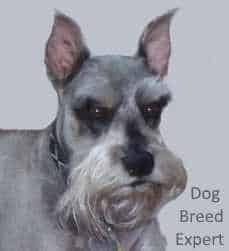
The dog above has cropped ears, (maybe not the best crop job) but cropping has still remained the preferred appearance for show dogs at least in the U.S.A. Many other countries have either discouraged the practice or outright banned the cropping of ears and docking of tails.
If you have your heart set on a schnauzer and have a strong opinion on either docking or cropping, please discuss this with your breeder. Tails are usually docked at about 3 or 4 days of age, so you will want to make sure your preference is known even before the puppy is born.
Famous Miniature Schnauzers
Sam– Avril Lavigne’s Mini Schnauzer
Bruce Lee owned a Mini Schnauzer
Angel– belonging to Cesar Millan
References and Further Reading
Dog Breeds Expert always recommends that anyone interested in a particular breed should check out as many sources of information about the breed prior to searching for the perfect puppy or adult dog. The following resources are recommended and a way to start your search for the perfect breed for you.
U.S.A. Parent Club
The American Miniature Schnauzer Club

